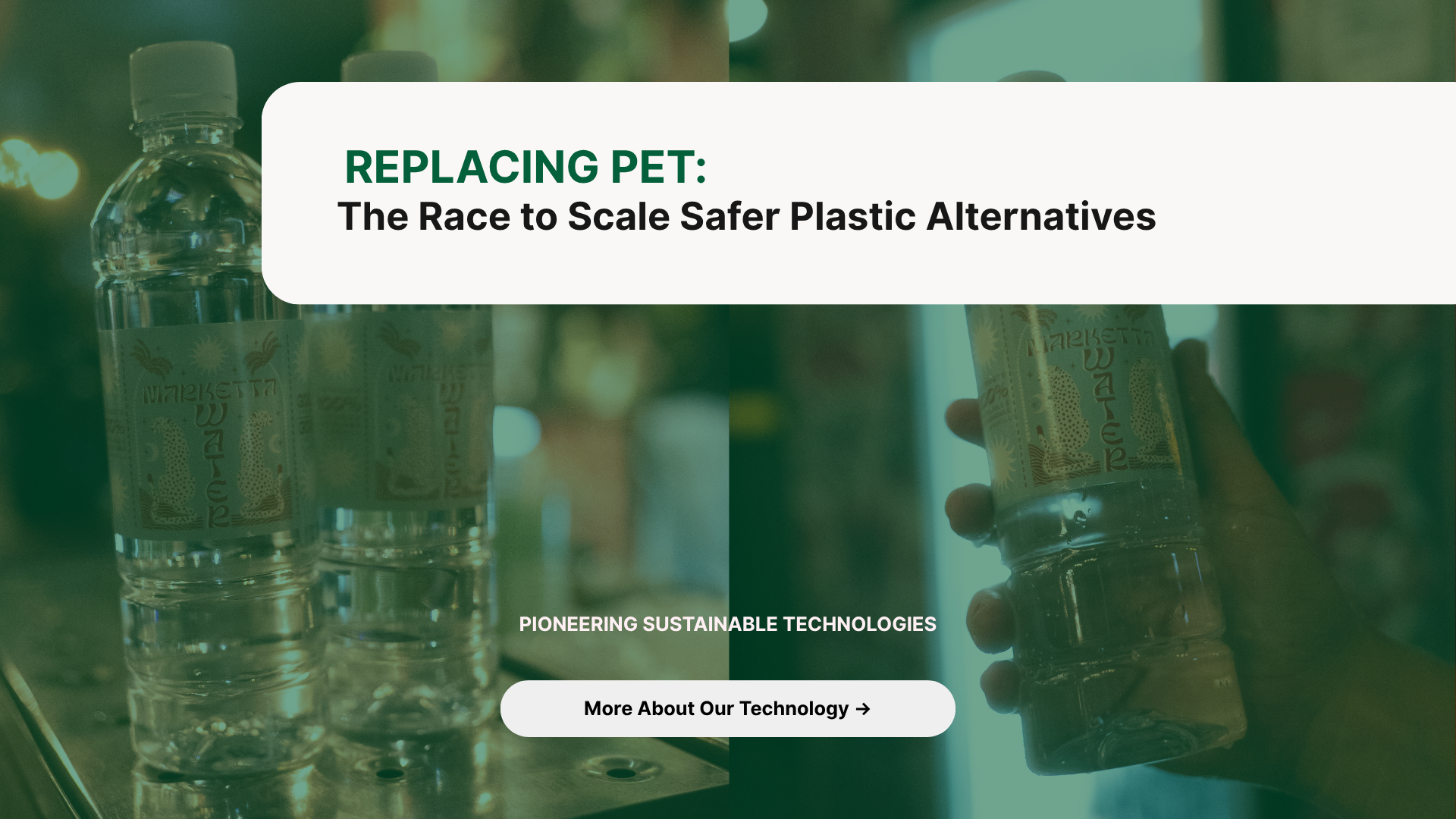Polyethylene terephthalate, or PET, remains the dominant material used for plastic bottles worldwide. Despite being marketed as recyclable, PET continues to generate long-term environmental risks. In 2025, mounting scientific evidence, regulatory scrutiny and consumer pressure are accelerating global demand for safer alternatives.
This blog examines the urgent push to replace PET with materials that do not persist in landfills, fragment into microplastics or release toxic compounds during degradation. It explores the technical, economic and regulatory challenges of scaling viable alternatives and highlights the critical role of certification and infrastructure alignment in enabling widespread adoption.
Why Replacing PET Matters for Global Health and the Environment
PET bottles are often labelled as recyclable, but the reality is more complex. Global recycling rates remain below 50 percent, and many PET bottles are either incinerated or buried in landfill. Over time, these materials break down into microplastics and nanoplastics, entering soil, water and the human food chain.
Research published in the journal Environmental Science & Technology confirms that PET breakdown products have been detected in tap water, bottled water and aquatic life. These particles have been associated with endocrine disruption, cellular damage and bioaccumulation in human tissues.
In Australia, where only 30 percent of plastic bottles are recycled, PET continues to dominate the bottled water and soft drink market. Without effective alternatives, the country remains dependent on a polymer that fails to degrade safely and poses increasing risks to public health and biodiversity.
Biodegradable and Compostable Plastics Enter the Market
In response to these risks, the market for biodegradable and compostable plastics has expanded significantly. Materials such as polylactic acid (PLA), polyhydroxyalkanoates (PHA) and starch-based blends have entered consumer packaging, food service and agriculture.
However, not all biodegradable plastics are equal. Many require industrial composting conditions that are not widely available. Others may still release microplastic fragments during degradation or fail to break down fully in landfill environments.
To meet the definition of a safer PET alternative, a material must decompose naturally in common disposal environments such as landfill, while leaving no toxic or persistent residues. It must also perform under the same functional conditions as PET, including water resistance, durability and shelf-life.
Certification Is Key to Market Credibility and Policy Compliance
In 2025, government regulations are tightening around plastic labelling and claims. Certifications from recognised international bodies such as TÜV Austria, BPI and ABA are now critical to demonstrate that a product truly biodegrades under landfill, marine or composting conditions.
For biodegradable products, third-party certification is not optional. It is essential for regulatory compliance and consumer trust. Companies using verified additives that enable full breakdown into non-toxic compounds are better positioned to meet emerging legislation and procurement standards.
The Greener Tech Group’s The Eco Bottle, for example, has achieved certification for its ability to decompose fully in landfill without leaving behind microplastic particles, methane or chemical residue. Its core technology, based on depolymerisation, represents one of the few PET alternatives proven to work in the absence of industrial composting facilities.
Challenges Slowing the Transition from PET
Despite growing interest, several barriers continue to delay the large-scale replacement of PET. These include:
- Manufacturing scale and supply chain limitations
- Higher unit costs for biodegradable materials
- Lack of consistent global standards for biodegradability
- Confusion around bio-based versus biodegradable terminology
- Insufficient consumer education about disposal pathways
In many regions, plastic packaging legislation still favours recycling over biodegradation. PET remains entrenched in existing collection, processing and resale systems. This has made it difficult for emerging materials to compete on cost or scale without policy intervention.
Global Policy Signals Are Beginning to Shift
Countries including France, India, Canada and Kenya have introduced restrictions or bans on specific plastic polymers. The European Commission’s Circular Economy Action Plan now includes directives aimed at replacing fossil-based plastics with biodegradable options that meet verifiable end-of-life criteria.
In Australia, the 2025 National Packaging Targets require 100 percent of packaging to be reusable, recyclable or compostable. However, no national infrastructure exists for industrial composting of biodegradable plastics. This gap reinforces the need for landfill-compatible alternatives that do not rely on specialised systems.
Trade partners are also demanding change. Japan and the European Union have introduced labelling requirements and plastic content disclosure standards that affect import eligibility. Exporters unable to demonstrate compliance may face restricted access or tariffs under green trade agreements.
The Eco Bottle and the Business Case for Immediate Adoption
For businesses seeking to align with ESG benchmarks and future-proof their product lines, PET replacement is no longer an optional innovation. It is a core compliance issue and brand differentiator.
The Eco Bottle offers an immediate and verifiable solution. It functions identically to PET in use, but breaks down safely in landfill through a certified depolymerisation process. Unlike plant-based plastics that still use fossil-polymer blends, The Eco Bottle contains no microplastic-generating ingredients and has been independently tested for safety and efficacy.
Because it does not require new infrastructure or consumer behaviour change, The Eco Bottle fits seamlessly into existing supply chains while delivering measurable environmental benefits. For companies selling into jurisdictions with strict plastic regulations, it offers a low-risk pathway to compliance.
What Is Needed to Scale Safer Alternatives Globally
To accelerate the replacement of PET, three areas require immediate attention:
- Policy alignment that recognises landfill-compatible biodegradability as a viable path
- Public procurement programs that prioritise certified biodegradable products
- Investment in R&D and scaling to bring unit costs down and increase global availability
The market is ready. The data is clear. Consumers, investors and regulators are demanding change. It is time to shift away from legacy plastics that pollute land, water and food systems toward materials designed for environmental safety and circular value.
Key Summary
✓ PET continues to dominate global plastic bottle production despite health and environmental risks
✓ Scientific research confirms PET bottles release microplastics and toxic degradation by-products
✓ Biodegradable alternatives must decompose fully in landfill, not just in industrial composting
✓ Certification is essential for compliance, credibility and access to international trade
✓ The Eco Bottle uses depolymerisation to break down safely with no microplastics or gas emissions
✓ Policy shifts and ESG pressures are accelerating the need to scale safer plastic materials
✓ Businesses that adopt certified alternatives can secure market access and reduce legal risk

